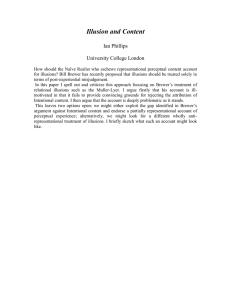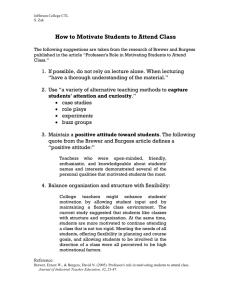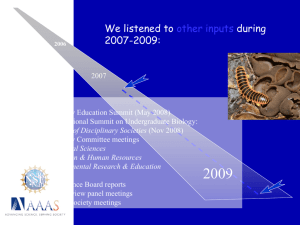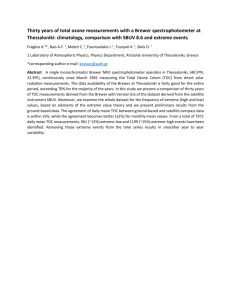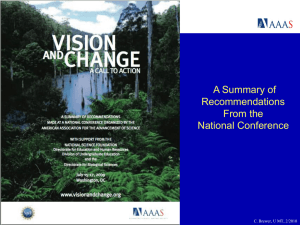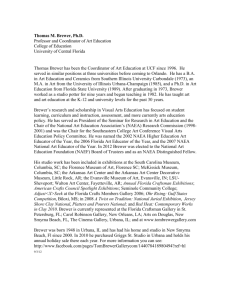Illusion and Content October 2005
advertisement
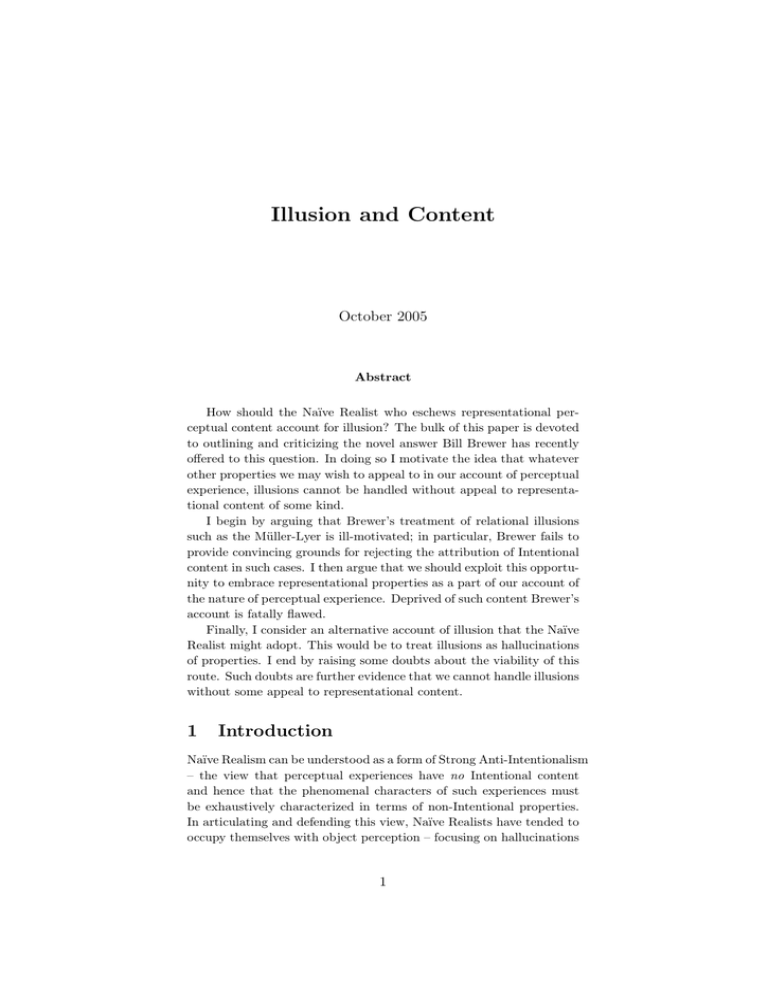
Illusion and Content October 2005 Abstract How should the Naı̈ve Realist who eschews representational perceptual content account for illusion? The bulk of this paper is devoted to outlining and criticizing the novel answer Bill Brewer has recently offered to this question. In doing so I motivate the idea that whatever other properties we may wish to appeal to in our account of perceptual experience, illusions cannot be handled without appeal to representational content of some kind. I begin by arguing that Brewer’s treatment of relational illusions such as the Müller-Lyer is ill-motivated; in particular, Brewer fails to provide convincing grounds for rejecting the attribution of Intentional content in such cases. I then argue that we should exploit this opportunity to embrace representational properties as a part of our account of the nature of perceptual experience. Deprived of such content Brewer’s account is fatally flawed. Finally, I consider an alternative account of illusion that the Naı̈ve Realist might adopt. This would be to treat illusions as hallucinations of properties. I end by raising some doubts about the viability of this route. Such doubts are further evidence that we cannot handle illusions without some appeal to representational content. 1 Introduction Naı̈ve Realism can be understood as a form of Strong Anti-Intentionalism – the view that perceptual experiences have no Intentional content and hence that the phenomenal characters of such experiences must be exhaustively characterized in terms of non-Intentional properties. In articulating and defending this view, Naı̈ve Realists have tended to occupy themselves with object perception – focusing on hallucinations 1 rather than illusions and simply slotting in predicates to locutions fitted for talk about objects as if this were an uncontentious step. Bill Brewer’s recent work bucks this trend. In particular, it raises the crucial question: how should the Naı̈ve Realist account for illusion? In this paper I examine Brewer’s own answer and consider what wider lessons the problems it faces can teach us. I begin (#2) by characterizing Brewer’s Object View (OV) as a particularist view of perception. In this light, I consider Brewer’s general account of illusion and specifically the Müller-Lyer. I argue that his treatment of the Müller-Lyer is under-motivated (#3); in particular, Brewer fails to give any convincing reasons for rejecting the attribution of Intentional content in such cases. Moreover there are good reasons to think that without such content his view is deeply unsatisfactory as an account of such illusions (#4, 5). Finally, I consider an alternative Naı̈ve Realist account of illusions (#7). One option would seem to be to treat them as hallucinations of properties. I end by raising some worries we ought to have about taking this route. 2 The Object View In Brewer’s first anti-representationalist paper, (OV) is glossed as the view that perceptual experience. . . simply acquaints [one] with various mind-independent things, whose actual perceptible features constitute the subjective quality of [one’s] experience. (70) It is natural to wonder how this position really differs from Brewer’s old Perception and Reason view (Brewer, 1999), on which phenomenal character is understood solely in terms of doubly world-dependent Intentional contents. In particular, such an Intentionalist Actualist (as we might call him) will claim: 1. That worldly objects and their qualities are “constituents” of experience in that without their existence or instantiation the experience could not have been the kind of experience it is; and, 2. That the object-dependence of an experience’s Intentional content is enough to capture the datum that genuine perceptual experience “presents us with the objects in the world around us as they actually are” (Brewer, unpublished). After all, for McDowell and the early-Brewer, when a de re sense is given to the mind an object is given to the mind just in a way. The 2 contrast with the mind’s being given some generalized set of descriptions is clear.1 Brewer’s most recent paper (Brewer, unpublished) suggests clear way of drawing the needed distinction. In summary: having a representational content is a matter of having a content with a truth or satisfaction condition. To have a content with a satisfaction condition an experience must relate the world to some general condition that it might meet, a condition which fixes the extent to which the world may vary before the relevant content would lapse from truth to falsity. In effect, the idea is simply – indeed, arguably truistically – that an experience with a representational content represents things as being some way. As Crane puts it, To say that any state has content is just to say that it represents the world as being a certain way. It thus has what Peacocke [(Peacocke, 1992)] calls a ‘correctness condition’ – the condition under which it represents the world correctly. (Crane, 1992, 139)2 In the case of a particular object which figures in the representational content of some state or event, the particular in question must be represented as being some specific general way, that is, as falling under some general concept. This is true both in the case of an ordinary subject-predicate thought with the content that a is F and also in the case of doubly world-dependent subject-predicate contents such as that that (object) is thus and so (in respect of colour, height, weight etc.). In the latter case, even if it is true that the identification of the general condition rules out the possibility that the particular in question might fail to fall under the relevant concept, this does not detract from the fact that the particular figuring in the content must be represented as meeting some determinate general condition of satisfaction which, as Brewer puts it, “infinitely many qualitatively distinct possible objects” might meet. The notion of a satisfaction condition, involving as it does a certain kind of selection from, and categorization of, the scene we are confronted with, thus, essentially, brings with it the involvement of a kind of generality. This can be captured as follows: if an object figures in a representational content, then it is always represented as being some general way. The Strong Intentionalist (i.e. someone who holds that the phenomenal character of perceptual experience can be exhaustively characterized by reference to its Intentional content) is committed to the claim that talk of particular objects constituting the phenomenal char1 2 C.f. (McDowell, 1994, 26 and passim). See also (Martin, forthcoming, ch.3:13). C.f. (Sturgeon, 1998, 190). 3 acter of experience is equivalent to talk of such objects essentially figuring in the representational content of that experience. Thus, the Strong Intentionalist is committed to the claim that experience essentially involves generality, in that objects are always represented as being certain ways. This claim is precisely what is rejected by anti-representationalism, at least in (OV) form. Brewer’s view of perception is essentially and wholly particularist; perception “is. . . a matter of the conscious presentation of actual constituents of physical reality themselves, particular such things, just as they are” (my emphasis). That is, experience consists in the unadulterated presence of a particulars. Experience does no more than acquaint us with objects – no general conditions are placed on them – they are not combined or conceptualized. Brewer’s purpose in linking the possession of satisfaction conditions to the presence of generality is to highlight that Anti-Intentionalism has deep phenomenological implications. In particular, (OV)’s denial of generality is phenomenologically motivated. For, according to the Content View (CV), according to which experience has some intrinsic Intentional content, perceptual experience supplements any direct openness to physical reality as it is in itself with some intellectual act of classification or categorization. [This] constitutes an unwarranted intrusion of conceptual thought about the world presented in perception into the (CV) theorist’s account of the most basic nature of perception itself, at least by the lights of the Berkeleyian insight. . . that perceptual experience simply opens the subject’s mind. . . to the constituents of the physical world itself. (Brewer, unpublished) 3 Strong Anti-Intentionalism and Illusions The Object View and views like it will have to tell a disjunctivist story about hallucinations. In particular, as Mike Martin has argued at length, they will have to deny that the phenomenal nature of hallucinations can only be characterized epistemically – as subjectively indiscriminable from veridical perception (Martin, 2004), (Martin, 2005). One might attempt to tell the same story in the case of illusion, that is one might treat illusions as hallucinations of properties (see #7). Alternatively, one can deny that illusion is strictly a phenomenological matter at all. This is the option taken by (OV): ‘Illusions’. . . are absolutely not cases in which there is some kind of misrepresentation of reality by perceptual experience. . . . Rather, they are cases in which the way that the 4 subject is most naturally inclined to judge the world to be, given which features of mind-independent reality are accessible to him in experience in this way, is systematically out of line with the way things actually are out there. (Brewer, 2004, 74) This judgement-based account claims that phenomenologically both illusion and veridical perceptions just are ordinary perceptions but ordinary perceptions in which our judgment is misled.3 There is no question of misrepresentation occurring within experience. Let us focus on Brewer’s discussion of the Müller-Lyer. This is the positive description he gives of that case: . . . perceptual experience itself presents the very lines out there, distributed in space as they actually are. In particular, their identity in length is a perceptible feature of the lines, which is made experientially accessible to the normal subject. (Brewer, 2004, 70) The illusion arises because we “naturally and explicably” make mistaken judgments concerning the presented scene: judgment is understandably led astray by the hashes in arriving at the conclusion that the lines are different in length. On a popular view, this is due to the fact that one wrongly equates the length of each line with the distance between the centroids of the triangles two-thirds constituted by the relevant hashes, to which attention is quite naturally drawn. (ibid.) There are a number of other competing explanations of the illusion. Another popular account, illustrated in Fig.1, is that, when we usually see Müller-Lyer configurations of lines, we are in situations where the arrowhead lines are, in fact, receding and the splayed lines are, in fact, sloping towards us. Hence, in such configurations the vertical line is usually respectively closer or further away from us than the diagonals. According to Brewer, in all cases, our experience simply acquaints us with each given line. However, faced with a pair of configurations as above, we are usually correct to judge that the vertical in the arrowhead configuration is closer to us than its diagonals and the vertical in the splayed configuration is further away. Thus, we are correct to judge that the splayed vertical is the longer. Müller-Lyer cases are deliberately constructed so as to mislead us on this score and we quite understandably go awry. Brewer believes that his account of the Müller-Lyer is preferable to the account given by (CV) in terms of misrepresentation. He argues 3 Doubtless, Brewer would avoid talk of veridical perception. 5 Figure 1: Perspective Explanation of Müller-Lyer Illusion for this claim in both negative and positive ways. First, he argues that the (CV) account is flawed, then he argues in favour of what he describes as “experienced identity in length”. Both arguments fail. Their failures reveal a potentially attractive view of illusions which combines elements of particularism and Intentionalism. 3.1 Intentionalism and the Müller-Lyer Brewer attacks (CV)’s account of the Müller-Lyer on the following grounds. Suppose that Elly is faced with the Müller-Lyer diagram, which she has never seen. Gradually the hashes at the ends of each of the two main lines shrink in size until eventually they vanish. She does not have a sequence of experiences representing the two main lines as gradually changing in length - one growing and/or the other shrinking - until they coincide, as (CV) presumably contends. Indeed pressing the question precisely how much longer, or shorter, than it actually is, each line is represented as being at any point just does not make sense. Instead, she gradually comes to realize that her previous judgement that the lines were unequal in length was mistaken. She is evidently presented throughout with the very same pair of lines, equally extended in space as they actually are, whose unchanging identity in length becomes gradually more apparent to her. . . (Brewer, unpublished) It is not clear what Brewer’s basis for his claim about Elly’s potential experience is. It seems eminently questionable and it would cer- 6 Figure 2: Café Wall Illusion tainly be interesting to see psychological data which supported Brewer’s assertion across a range of subjects.4 However, rather than merely question Brewer’s intuitions, I want to turn to a similar illusion where the analogous claim seems deeply implausible, i.e., where the analogous feature to constancy of line length is not at all evident. The example to consider is Gregory’s Café Wall Illusion (Gregory & Heard, 1979), (Gregory & Heard, 1983). The illusion involves parallel rows of alternately coloured ‘bricks’ separated by a thin line of ‘mortar’. Depending on the offset of the edges of the bricks with respect to the edges of the rows above and below, the bricks appear to increase in height along the wall. As the offset is decreased to zero, the appearance of increasing height disappears. Similarly, as the thickness of the ‘mortar’ lines are increased or decreased in size, the illusory effect reduces. And finally, as the brightness of the ‘mortar’ lines is reduced, the illusory effect also gradually diminishes. A static picture of the original café wall which inspired Gregory is reproduced in Fig.2. However, the reader unfamiliar with the illusion and the effects of gradually changing the parameters is strongly recommended to look at the excellent dynamic demonstration of the illusion which can currently be found at http://www.essex.ac.uk/psychology/visual/cafewall.html. What seems clear from a encounter with the the dynamic case is that – in contrast to Brewer’s account of the Müller-Lyer – this is a case where the gradual alteration of the parameters which lead to the illusory effect (mortar width, mortar brightness and edge offset) clearly does correlate with a genuine alteration in the phenomenology. 4 One wonders whether our intuitions are any different in the case of hashes being gradually added to the lines. 7 It seems off-key to describe the situation as one where all that shifts is one’s inclinations to judge. In particular, the lines of bricks do seem literally to straighten when the bricks are moved gradually sideways or the mortar width reduced. I am not suggesting this is a fatal counter-example to (OV). Firstly, a much wider range of cases need attention. Secondly, (OV) can, if pushed, simply appeal to gradual alterations in our natural inclinations to make errors of judgment to handle the Café Wall case, even if this line seems unattractive here. The point is rather that such cases undermine the particular support Brewer attempts to garner for (OV) when he notes that the characteristic phenomenology of gradual removal of hashes is not one of the lines changing in apparent length. For here we have a case where it is precisely the case that the characteristic phenomenology is of such changing spatial parameters, the result Brewer thinks (CV) predicts. In the above passage, Brewer also attacks the (CV) account of how the representational content alters during the removal of hashes. For according to Brewer, “the question precisely how much longer, or shorter, than it actually is, each line is represented as being at any point just does not make sense.” Brewer’s remark is quite right, it is just orthogonal to the issue at hand. What it true is that our experience does not represent each line, taken individually, as being longer than it actually is. That would be absurd. However, it does not follow from this fact that experience does not represent the relational representational fact that the two lines are of different lengths. Perhaps, Brewer’s worry is rather that this relational representational fact cannot be precisely specified, in that it does not make sense to ask for a certain kind of precision when questioning how much shorter than the other line the arrow-headed line is represented as being. However, if this is right, Brewer is placing unwarranted demands on Intentionalist accounts of perceptual experience. For example, the tallest object on the skyline beyond my window is an oak tree. Suppose we ask: precisely how much taller than everything else in the scene is the oak represented as being by my experience? Surely the Intentionalist is not committed to an answer of the form: the tree is represented as being 6.73m taller than the surrounding shrubbery. Instead, all it need say is that the tree is represented as being around twice as tall as the nearby structures or, perhaps, as that much taller than the shrubs. Similarly, the Intentionalist can hold of the Müller-Lyer lines as the hashes are removed that, at time t1 , line a looks significantly longer than line b, that, at t2 , line a is presented as being just a little longer than the line b and, finally, at t3 , that the lines are represented as being the same length – that the lines now look the same length. No doubt Brewer is right to point out that more needs saying about the nature 8 of perceptual representation here, but it is not at all obvious that such representation need be subject to demands it cannot meet. 3.2 Experienced Identity in Length Brewer also uses his removal of hashes argument to support a positive claim of (OV)’s, namely that “their identity in length is a perceptible feature of the [Müller-Lyer] lines, which is made experientially accessible to the normal subject” (Brewer, 2004, 70). The argument is unsuccessful for the reasons already set-out. However, Brewer offers another argument in favour of experienced identity in length. It is instructive to see why it also fails. This, second argument “in favour of. . . experienced identity in length” contends that if asked to point to the ends of the two lines, normal subjects point accurately, that is to say, they experience the endpoint of each line to be where it actually is. These pairs of points are of course equidistant. That is to say, the extents of space that the two lines are perceptually presented as occupying are identical. (70) The problem with this chain of reasoning is that, even if we grant that the phenomena in question demonstrate that subjects experience the endpoints of the lines to be where they actually are, this does not mean that they experience the two lines’ identity in length. It is, of course, true that the distances between the known locations of the endpoints are (as a matter of fact) the same, but this does not mean that this sameness of distance is known, experienced or experientially accessible. Subjects may experience each line to be exactly the length it is without their identity in length being an experientially accessible feature. Indeed, the anti-representationalist should question whether they need to endorse Brewer’s claim that in cases like the Müller-Lyer “[the lines’] identity in length is a perceptible feature of the lines, which is made experientially accessible to the normal subject.” Such a claim raises a dilemma concerning the nature of the experiential accessibility in question. If the property of identity in length is accessible to our personal-level psychological faculties via experience, then it seems extremely difficult to understand how we can be misled in our judgments. After all, such accessibility is surely accessibility to our psychological faculties. Yet, if one of the things that we are aware of and that can serve as the basis for our judgment concerning the lines’ relative lengths, is that the lines are identical in length, it seems very hard to understand the persistence of our judgments to the contrary.5 5 There is the deeper issue of whether one can make sense at all of the idea of features 9 In the context of Brewer’s discussion of Bruce Bridgeman’s frameshifting experiments, it might appear that Brewer’s considered view is that the lines’ identity in length is experientially accessible only to one’s “action-guidance system” as opposed to a system “more concerned with the identification and categorization of perceptually presented items.” (Brewer, 2004, 71) However, if this is the case, we are still required to say what features of the presented scene are experientially accessible to the faculty of judgment. It is, after all, clear that when Brewer talks about “the move from perceptual presentation to beliefs about how things are” (72) he views this move as more than a merely causal transition along the lines of (Davidson, 1986). Yet, without an account of the move, we remain in the dark as to the nature of experiential accessibility. At this point, I recommend that the anti-representationalist abandon the claim of experienced identity in length and, consequently, the idea that such a property is a perceptible feature of the lines. Instead, (OV) should hold that we simply perceive each particular line (which is, of course, just the length it is). We do not experience their identity in length. However, if the claim of experienced identity in length can be dropped, then we are free to make the following proposal about MüllerLyer experiences: they are cases in which we are presented or acquainted with each particular line. However, such lines are also falsely represented as being of different lengths to each other. The Intentional content of the experience involves the misrepresentation of one line as being longer than the other. This explains why our mistaken judgments are rationalized by experience whilst also retaining the direct presentation of the world in experience. In other words, whilst Naı̈ve Realist intuitions may only be captured by the positing of particularist properties in perception, it is a mistake to assume that positing such properties is incompatible with experience also having Intentional properties.6 Rather Naı̈ve Realist intuitions leave it quite open whether experience has Intentional properties or not and nothing in the Müller-Lyer case tells against such properties precisely because of the relational nature of the illusion in question. being experientially accessible without appeal to the cognitive and Intentional. 6 This assumption of exclusivity is evident in the contrast Brewer draws between (OV) and the Content View (CV). In its weakest form, (CV) simply holds that experiences have an intrinsic Intentional content. (OV) rejects any form of Intentionalism. Thus, Brewer explicitly factors the space of options into two mutually exclusive views of experience (Brewer, 2004, 69). Weir similarly describes his ‘ultra-realist’ theory of perception as an “utterly non-representational” theory which “completely rejects any representational element in perception” (Weir, 2004, 105-6). For a clear denial of exclusivity see (Price, 1932, 7). 10 Figure 3: Jastrow’s Duck Rabbit Figure Given this, someone impressed by the motivations for (OV) should not feel forced into pursuing the kind of judgement-based account of the Müller-Lyer illusion that Brewer does. This is a relief since, as I now argue, such a judgement-based account is deeply problematic. 4 Phenomenology and the Aspect Shift Analogy It is hard to read Brewer’s account of illusions without wanting to bang the table and insist that the account just misses out the introspectively obvious fact that the lines look, that is look phenomenologically, to be different in length. Here I want to bolster this intuition briefly by considering the seemingly analogous account of aspect shifts. Aspect shifts are occasions on which we see both that some figure or object is unchanged and yet we see the figure or object in a different way, under a different aspect. The most famous example of a double-aspect figure is probably Jastrow’s Duck Rabbit (Jastrow, 1900) (Fig. 3).7 Attention to the character of our own experience strongly supports the claim that aspect shifts involve alterations in the phenomenal characters of our experiences. The particularist (OV) faces a problem here because he must explain the phenomenological side of aspect shifts 7 But consider also the surely experiential difference between hearing a language one knows and an alien tongue as well as inter-lingual cases of semantic feedback such as described in (Quine, 1987, 167). 11 solely in terms of direct acquaintance with a particular set of lines; solely in terms of the things seen. Yet the things seen, the lines on the page, precisely do not change. As Budd puts it, there is no change “with respect to colour, two- or three-dimensional shape, distance or the distances of any of its parts from the perceiver.” (Budd, 1989, 89) Now, there may be things that the (OV) theorist can say here. However, a judgement-based account seems quite incredible. Such an account would hold that aspect shifts are cases where the phenomenal character of the experience does not change and what change are simply the similarities one notices when contemplating an experience of the very same kind. This appeal to post-experiential interpretation is thoroughly unpalatable from a phenomenological perspective. The most natural way to describe what happens when the aspect under which one sees some figure shifts is in terms of a genuinely experiential change. The figure seems to change suddenly before one’s eyes. The experience sometimes surprises us – suddenly a new aspect leaps out – and is often unexpected. One can enjoy the game of switching between aspects. In all these ways, aspect changing is a distinctly phenomenological occurrence. Of course, no-one wishes to deny that one of the things which may change when one’s experience undergoes a change of aspect is our disposition with respect to the presented object: the way we are likely to act upon it or explain our experience of it and so forth. Dissatisfaction with the interpretation view arises because it seems that this cannot be all there is to the matter. Indeed, one wants to know why our disposition changes – what grounds our new way of going on. Strawson (Strawson, 1970) has suggested that the dawning or shifting of aspects simply dramatizes a more general feature of our perceptual experience, namely that when we see an enduring object we typically see it as an object of a certain kind or as a particular individual. Again, this general feature of experience seems to be part of the phenomenology of experience. If this is right then, pace Berkeley, perception does not simply present the actual particular constituents of the physical world. Instead, what Brewer thinks of as “the simple presentation to a subject of the constituents of the physical world themselves” is, as Strawson puts it, intrinsically infused or saturated with concepts (Strawson, 1992, 62-3). Evidently, once we admit this aspectual element to ordinary perceptual experience our resources for handling illusion become much richer. I now turn to a direct consideration of the illusory case. 12 5 Justification and Natural Powers Matt Soteriou raises the following dilemma for any anti-representationalist account of illusion of (OV) form.8 According to (OV), when subjects are confronted with the Müller-Lyer lines they are tempted to make mistaken judgments about their relative lengths. Are such judgments rationalized by the phenomenal character of such experiences? If the anti-representationalist answers ‘no’, then they are committed, as Brewer concedes, to holding that a subject “might have had precisely the same experience, with just this subjective character, and yet had no such felt temptation to mistaken judgement whatsoever. In that case there would be no illusion, according to the [(OV)] account.” Yet, as Brewer acknowledges, we cannot make sense of such a situation. Even to someone well acquainted with the Müller-Lyer, who has no consequent inclination to false judgement, the illusion remains. (Consider how we would react to the awkward and precious schoolchild who, on first being shown the illusion by his teacher, insists that the lines look just the same length just to be difficult.) Brewer rightly admits that this option is untenable. The anti-representationalist must, therefore, say that our mistaken judgements are rationalized by the phenomenal character of perceptual experience. However, if this is so, then, as Brewer puts it, whatever grounds the temptation to make such a judgement also affects the subjective character of the experience. So there may be two subjects, both presented with the same arrangement of equal lines (plus hashes) in the world, only one actually tempted to make the mistaken judgement, and hence with experiences of different subjective characters. Thus, this subjective character is not exhaustively determined by the objects and features presented, but must also depend to some extent upon its representational content. (Brewer, unpublished) Brewer replies to the objection as follows: My reply to this line of argument is that its objection to the second horn of the purported dilemma is ineffective. . . . Faced with the Müller-Lyer diagram, a person’s perceptual experience rationalizes the mistaken judgement that the equal lines are unequal in length. . . precisely by presenting those very lines just as they actually are - equal in length but accompanied by misleading hashes - which themselves constitute a perfectly intelligible ground for that very judgement. . . . The perceptually presented diagram 8 See (Brewer, unpublished). 13 grounds such a judgement. . . in virtue of whichever of its similarities with two genuinely unequal lines in the world it turns out to be, whose salience would explain her mistakenly making the judgement of identity in length if she did so. (ibid.) In what follows, I raise a number of difficulties for this story. I conclude that the objection to the second horn of the dilemma cannot be avoided in the way Brewer avers. 5.1 Which natural and explicable false judgments are illusions? First, consider how Brewer might try and distinguish visual il lusion from delusion in general. He tries to do so as follows: Not every case of a perceptual experience prompting a mistaken judgment constitutes an illusion. For example, if someone suddenly, and falsely, comes to believe that the world is about end on seeing a particular arrangement of furniture in a room, then this is clearly not a case of visual illusion of any kind. I do not have a fully satisfactory characterization here; but what we count as perceptual illusions are just those cases of perceptual experience naturally and explicably leading to mistaken judgments about the world. . . (Brewer, 2004, 74) The difficulty is that it is not at all obvious that the judgments we find natural and explicable are coextensive with how things look visually. We might judge on the basis of perception that the cherries on the table are succulent, an orange may look juicy; we might judge that the dog is dangerous, the manure may look smelly. The fruits may, in fact, be dry and rotten, the dog docile, the manure fragrant. If so we are naturally and explicably misled but we are not subject to a visual illusion. How is Brewer going to draw this line? Similarly, one may naturally and explicably judge that things have certain properties on the basis of one’s visual experience and yet these not be properties that things look like they have. You know you’re wearing red-lenses and so things look red. But you also know that the shade of grass you’re looking at which looks red is, given its look, light green. You naturally and explicably judge this to be so.9 In these cases, Brewer will no doubt claim that your most basic natural inclination is to judge that the grass is red. But what is the basis for this claim? Can one legitimately set aside background beliefs in understanding the 9 Compare Anscombe who notes that “often things looks to us, strike us, not as they look but as they are!” (Anscombe, 1981, 14). 14 notion of the natural and explicable? That seems highly implausible. If one considers the kind of psychological explanations offered of the Müller-Lyer above, these are explanations which simply don’t work if one sets aside background beliefs and expectations – beliefs about how other things actually are when they look certain ways, for example. The Intentionalist will say that visual illusion only occurs when the content of one’s experience (as opposed to judgement) is falsidical. In contrast, the (OV) theorist cannot just appeal to the objects which constitute experience since the judgments in cases of illusion are precisely contrary to these objects’ properties. I doubt that naturalness and explicability can do the work Brewer needs here. Firstly, note that we certainly do draw an intuitive distinction between illusions and delusions. However, the naturalness and explicability test employs rather subtle and controversial psychological theories in its employment. For example, Brewer offers one of several psychological explanations in order to explain the Müller-Lyer. I outlined a different one. However, this uncertainty in explanation does not leave us in any doubt that this is a genuine case of illusion: we do not withhold judgment until scientists agree on an explanation of the case. Furthermore, there seem to be plenty of cases where mistaken judgements are quite natural and explicable and yet where we do not think of the case as one which involves illusion. I gave several cases above. But consider also that a racist may naturally and explicably make false judgments when they see someone with a particular skin colour but we do not regard such judgements as indicative of illusion. These judgments may even be based on objective visual similarities between particular races or colours and other creatures or things. Finally, consider the fact that the phenomenal character of our experience is constituted by the very lines out there, with their equal lengths. This surely provides an equally natural explanation as to why someone might have no inclination to think the lines were of different lengths. (Not least, because, according to Brewer, their identity in length is actually experienced!) Given this, it seems extremely hard to see how the notion of “naturalness and explicability” can do the work required without further theoretical machinery. 5.1.1 Persistence and Inclination Second, consider psychologist Fritz. Fritz has absolutely no inclination to make mistaken judgments about Müller-Lyer lines. He has had a lifetime’s exposure to such illusions and is now extremely good at judging correctly whether such lines are equal or not. Nevertheless, they still look unequal in length to him. Brewer wishes to explain the persistence of the illusion in such 15 cases by appeal to the fact that Fritz can understand other people’s (and no doubt his past self’s) natural inclinations to judge that the lines differ in length. And by appeal to the fact that (as even Fritz will acknowledge) such inclinations are entirely explicable given the relevant similarities. But, since Fritz does not even think to entertain the idea that the lines might not be equal nor, being rather self-absorbed, of how anyone else (his past self included) might think they were, how can such an explanation succeed in capturing the fact that the lines continue to look to be of differing lengths? (The Intentionalist will, of course, say the the Intentional content of the experience always represents this as so – no matter how Fritz does or doesn’t go on to represent things to himself.) Brewer elucidates his account in terms of the following analogy: Consider a parallel case of inferential illusion. There are some invalid mathematical inferences, in which a carefully concealed division by zero is made, for example, which remain evidently misleading even to a decently skilled mathematician who is utterly disinclined to believe their conclusion. For he can easily ‘see’ how others might be taken in by them: they retain that ‘look’ of validity. Other invalid inferences are poorly constructed, and so clearly would not fool anyone. The Müller-Lyer is in my view analogous to the former. In the mathematical case, the possibility of illusion only arises when one’s judgments come into play. There is no illusion if one does not consider whether the inference is valid or not – or whether it might be thought of as valid by someone else.10 This difference is telling since it is best explained by claiming that, insofar as we can make sense of a notion of an intellectual appearance, we do make sense of the notion in terms of the inferences which subjects are likely to make. Which inferences we find compelling is a matter of our training, expectations and background mental standing conditions at the time. In the perceptual case, though these factors are important, we primarily account for our judgments on the basis of experience in terms of the way the world appears to us in experience – in terms of the phenomenal character of the experience. Here, the notion of judgment does not explain the notion of appearance but vice-versa. 10 Another disanalogy is that one can easily imagine a mathematician (and not necessarily a highly skilled one) who feels no inclination to make relevant inferential move. When it is suggested that it would be natural to miss the division in question, she simply expresses bewilderment. 16 5.1.2 Content via the Backdoor Brewer’s appeal to natural and explicable judgments thus comes under significant pressure. That this reveals the need for Intentional content is witnessed by the fact that Brewer himself seems to unwittingly appeal to such content in the ensuing discussion. For example, in his account of the persistence of the Müller-Lyer illusion, Brewer writes: The lines look unequal in length. . . even to somebody who knows full well that they are not. Taking her experience at face value, and disregarding extraneous information about how the illusion works, this makes a mistaken judgment of inequality in length evidently natural and explicable. (Brewer, 2004, 71) Focus on the phrase “taking her experience at face value”. Is the idea that experience has a face value not simply the idea that experience has an Intentional content? This is Travis’ view in his antirepresentationalist paper The Silence of the Senses to which Brewer acknowledges a significant debt. There, Travis puts the point as follows: To take an experience at face value is to take it that suchand-such is so. So the face value of an experience is that such-and-such is so. (Travis, 2004, 59) Indeed, Travis takes the claim that experience has a face value to be definitive of representationalism, commenting that “you are my target if you think experiences have a face value” (83).11 No doubt the use of the phrase can be regarded as a slip of Brewer’s pen. However, if we allow Brewer this, we should remember that he has appealed to face value in order to explain the troubled notion of the “natural and explicable” misjudgement. Arguably, the unwitting appeal to content at just this point reveals just how difficult it is to make sense of illusion without the notion. In any case, insofar as Brewer’s account of natural and explicable judgments is mired in difficulties, the anti-representationalist remains skewered on Soteriou’s dilemma. 6 The Varieties of Illusion The Müller-Lyer is just one of many illusions in which (at least on the account mooted above) our experience misrepresents a relation between two or more particulars. Other examples I would place in this 11 It is interesting here to note that Martin is happy to talk about face value. See, e.g., (Martin, 2002, 399-400 and 413). 17 Figure 4: The Poggendorff Illusion category are the Poggendorff Illusion (Fig.4) and Titchener’s Circles (Fig.5). I hope it is relatively clear how the cases might receive a similar treatment. An immediate worry for either a judgement-based or content-based account of illusions is that there are many illusions which do not conform to this model. One such case is Hermann’s Grid (Fig.6).12 6.1 Hermann’s Grid The Hermann Grid illusion does not seem to rely on a false relational judgement. In Müller-Lyer cases we had two objects each of which individually we seemed to see correctly at least with respect to their non-relational properties. It was only the relational property that was misperceived. Here, however, we seem to see dark spots, that is particular spots, which are not there. It cannot be accounted for as I have suggested we ought to account for the Müller-Lyer. It cannot be given a judgement based account either, however. This is because there is evidently more to the phenomenology here than the presentation of the actual constituents of the scene about which we may or may not judge correctly. I suggest that we treat this kind of illusion as a case of hallucination. 12 The issues raised by Brewer’s account of the partially submerged stick are too complex to engage with here. 18 Figure 5: Titchener’s Circles Figure 6: Hermann’s Grid 19 Figure 7: The Hermann Hering Grid What makes this seem a reasonable move here is that the spots are particular objects. Further support can be garnered by noting the close similarities between these illusions and the occurrence of afterimages which are more commonly treated as cases of hallucination. See, for example, the Hermann Hering Grid (Fig.7). In this example stare at the black spot for thirty seconds and then immediately at the white dot. The after-image effects should then be apparent. As I have already mentioned the Naı̈ve Realist will need to tell a different story about hallucinations and that story can hopefully be applied here. 7 Illusion as Property Hallucination The following thought may now appeal to the Naı̈ve Realist: why not think of all illusions in terms of hallucination? Since, it would be seriously implausible to claim we hallucinated the lines themselves in the Müller-Lyer case, such an account would have to claim that illusions were hallucinations of properties (and relational ones at that) as opposed to particulars. However, if this were a reasonable thing to think then the disjunctive account of hallucination could simply be employed across the board. I end by noting what seem to me the dangers awaiting such a proposal. Those dangers can be appreciated if we ask the question: what kind of metaphysics would one have to adopt in order to think of illusions as hallucinations of properties? One could not, for example, be a nominalist who held that there 20 are no properties in something like the following sense: ¬∃x Property(x) And that it is simply a confusion to think that the quantifier is playing the same role in: ∃x x = x as it is in ∃F F = F The nominalist cannot offer a subjective indiscriminability account of all illusions. This can be seen by considering those cases where we wish to say that one does see all the particulars correctly and yet there remains some element of illusion. In this case it seems impossible to specify the veridical perceptual experience which the illusory experience is supposed to be subjectively indiscriminable from. One cannot specify a scene in which there are different particulars – this would fail to capture the genuine engagement with the world that is present in such a case. But once one has specified all the particulars in question there is nothing else for the nominalist to specify. Problems do not only arise for the nominalist. In fact, it is not obvious that even the most congenial metaphysics (e.g., endorsing a metaphysics of tropes on which properties-instances can be added and subtracted much like particulars) will avoid all the difficulties with the hallucination view. Return to the Müller-Lyer. Here, there is no obvious misperception of the length of the particulars themselves – this is something that the arguments Brewer offered above concerning pointing correctly to the ends of the lines correctly did seem to show. What I claimed is that we should say that we misrepresent the relational property which underpins the illusion (either in judgement or better in perceptual content itself). However, concerning the metaphysics of the case as opposed to what is visually apparent, once all the particulars and their non-relational properties are fixed there is no further question as to their relative length. That is not something that we could reasonably view as additional to the nature of the individuals themselves once their non-relational properties are fixed. Fix the lengths of two lines and you fix their relative lengths too. Thus, the hallucination view must claim that we hallucinate the individual length properties of at least one of the lines. But if we claim this then we cannot explain the fact that we do point to the ends of the lines correctly. 21 8 Conclusions In turns out then that the Naı̈ve Realist does not have a satisfactory answer to our original question concerning illusion. Brewer’s judgementbased account seems to fail for phenomenological and broadly epistemological reasons. And the hallucination view seems to face serious difficulties. In contrast, a more catholic view which thinks of perceptual experience in terms of both particularist and Intentionalist properties may well provide a satisfactory account of illusion. By rejecting Brewer’s operative assumption of exclusivity, such an account might plausibly do justice to the phenomenological motivations of (OV) without flouting the phenomenology and epistemology of this part of the mental landscape. References Anscombe, G.E.M. 1981. The Intentionality of Sensation. In: The Collected Philosophical Papers of G.E.M. Anscombe: Metaphysics and the Philosophy of Mind, vol. II. Blackwell. Brewer, Bill. 1999. Perception and Reason. OUP. Brewer, Bill. 2004. Realism and the Nature of Perceptual Experience. Philosophical Issues, 14, 61–77. Brewer, Bill. unpublished. Perception and Content. Working Draft. Budd, Malcolm. 1989. Wittgenstein’s Philosophy of Psychology. Routledge. Crane, Tim (ed). 1992. The contents of experience. CUP. Davidson, Donald. 1986. A coherence theory of truth and knowledge. Pages 307–19 of: LePore, Ernie (ed), Truth and Interpretation: Perspectives on the Philosophy of Donald Davidson. Oxford: Blackwell. Gregory, R. L., & Heard, P. 1979. Border locking and the Café Wall illusion. Perception, 8, 365–380. Gregory, R.L., & Heard, P.F. 1983. Visual dissociations of movement, position, and stereo depth: Some phenomenal phenomena. Quarterly Journal of Experimental Psycholology, 35(A), 217–237. Jastrow, Joseph. 1900. Fact and Fable in Psychology. New York: Houghton Mifflin. Martin, Michael. 2002. The Transparency of Experience. Mind and Language, 17(4), 376–425. Martin, Michael. 2004. The Limits of Self-Awareness. Philosophical Studies, 120, 37–89. 22 Martin, Michael. 2005. On Being Alienated. Unpublished manuscript. Martin, Michael. forthcoming. Uncovering Appearances. Unpublished Draft. McDowell, John. 1994. Mind and World. Harvard University Press. Peacocke, Christopher. 1992. A Study of Concepts. Cambridge MA: MIT Press. Price, H.H. 1932. Perception. London: Methuen. Quine, W.V. 1987. Quiddities. Penguin. Strawson, P. F. 1970. Imagination and Perception. Pages 31–54 of: Foster, Laurence, & Swanson, J. W. (eds), Experience and Theory. Duckworth. Strawson, P.F. 1992. Analysis and Metaphysics. OUP. Sturgeon, Scott. 1998. Visual Experience. Proceedings of the Aristotelian Society, 2, 179–200. Travis, Charles. 2004. The Silence of the Senses. Mind, 113(449), 57–94. Weir, Alan. 2004. An Ultra-realist Theory of Perception. The International Journal of Philosophical Studies, 12, 105–128. 23
